The beginning of boat building in India can be traced back to the stone age. A number of rock paintings in rock shelters datable to the mesolithic period provide evidence of boats and used by cavemen. All the known fishing scenes come from the sites like cave paintings at the sites Kowar Koh and Karwaghat in the district, Mirzapur.
India has had a long and continuous maritime tradition right from the time of the Indus Valley Civilization (3200-1750 BCE). This is reflected in the early archaeology of India. The tradition is still alive all along its coastline crossing over 7500 kms. The Harappans had internal as well as external trade. The Harappans had trade contacts with Mesopotamia and other regions of South Asia. The discovery of a tidal dockyard at Lothal has confirmed the archeological evidence of maritime activities of the mature Harappans. The discovery of Bahrain type seals at Lothal, show trade contacts with mature Harappan and West Asian regions. The other Harappan port towns are Kuntasi, Cambay, Padri, Dholavira and Prabhas Patan.
The Harappan traders were having colonies at Ur in Mesopotamia. On the basis of Mesopotamian inscription from Ur, their trade in eastern region was with Dilmun, Makana (Magan) and Meluhha as Katchch or Mohenjo-Daro or Ganeshwar. On the basis of an Akkadian inscription it is said that boats from Meluhha or Harappan region were bringing carnelian, ivory, shell, timber, textile and copper.
The terracotta model of an Egyptian mummy and a west Asian human head from Lothal and West Asian hair pins from Harappan sites and reserved slipwares and russet coated were from Surkotada, Lothal, Dholavira and Mohenjo-Daro also support the existence of trade with West Asia.
The Harrapan established their cities close to the Indus and its tributaries and the long coastline provided all the necessary facilities for the development of shipping. Ships have played a very important role for the trading communities of the Harappans. Ample archaeological evidence has been unearthed which make it clear that the Harappans were navigators and shipbuilders. They had regular maritime trade and contacts with distant lands including Mesopotamia. Ship representation found on a Harappan seal, terracotta tablet and a graffito on a potsherd from Mohenjo-Daro, a terracotta boat model from Lothal and a seal from Katchch are some of the direct evidence of their shipping and ship building activities. Five terracotta objects and a painting on a potsherd found at Lothal were identified as three types of ships of which two had sails. Detailed studies indicate that the Harappans made wooden ships.
Panini states that merchants were known as dvinavadhana (one having two boats) or panchanavapriya (one sailing with five ships). Later during the Gupta period, several ports on the west and east were opened as it were, to allow a free flow of commercial traders from inland emporia. The ports of Dwarka, Porbandar, Verawad, Ghogha and Cambay were soon full of goods from manufacturing centers of the interior in the north which in turn greatly revived maritime trade with European and African countries.
Hero stones are memorial commemorating the death of a leader/hero in a battle. Hero stones are found all over the country, some of them also carry some inscriptions. But hero stones depicting a naval battle are very rare, till date only a few have been discovered, mainly in the west coast only, like Mumbai, Goa and Gujarat. They are known by various names, Virakallu, virgals. The hero stones usually have three panels, however, some may depict four or five panels too. The first panel usually depicts the deity with attendants, the middle panel shows the leader/hero being escorted by attendants while the lower panel depicts the battle.
Apart from hero stones the depiction of maritime themes/ships etc. are depicted in various forms of art like, rock art, potteries, paintings, coins, ceramics etc.
Eksar memorial stones
There are some seven ancient virgals (memorial stones) in the vicinity of the newly built commercial. These sculptures are still worshipped by Adivasi people of the nearby Eksar Village, Borivali in Mumbai. According to Dr. Moti Chandra (in his book Sarthavaha, 1953), the carving at the lower panel shows a Naval war between Yadava prince Mahadeva and Someshwara Silahara in 11th century CE and mentions naval fights are depicted in the last two panels of the three virgals, but when I visited the site only one of the virgal had depiction of naval wars while in one virgal some traces of ships were evident (most of these virgals had been damaged over the time).
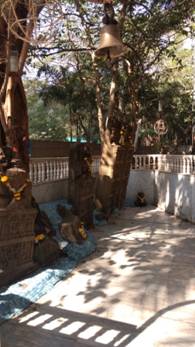
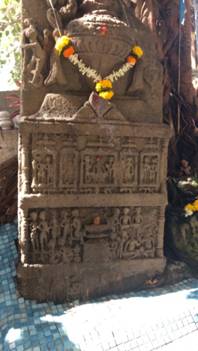
1. Seven Vergals (memorial stones) 2. Bottom panel shows some traces of ships
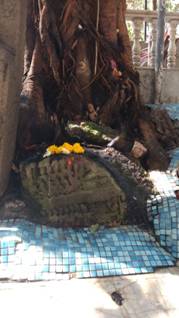
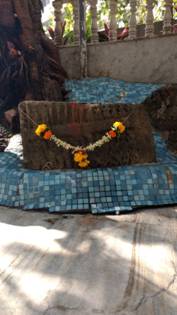
3. Fragments of the hero stone 4. Fragments of hero stone
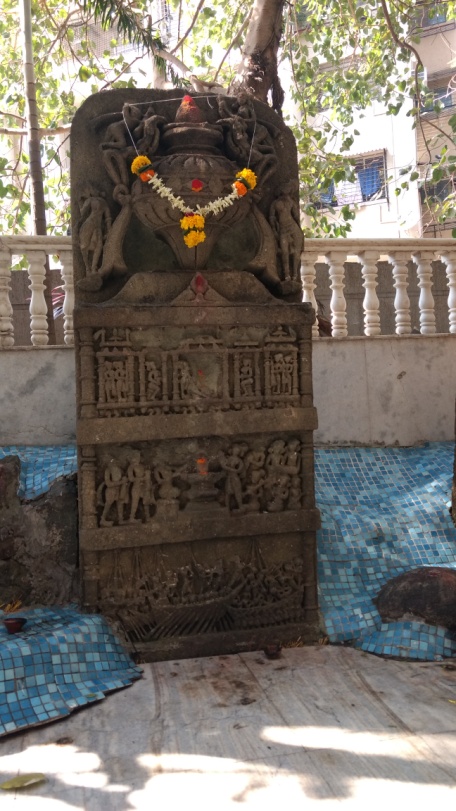
5. Lower panel depicts naval war
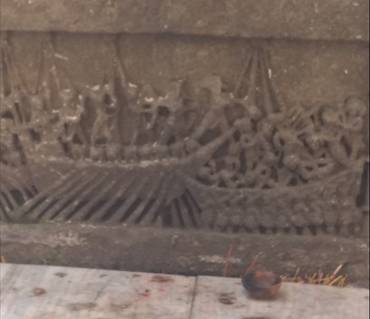
6. Close-up view of naval war

7. Two Vergals (Memorial Stones)
Goa hero stones
A number of hero stones depicting naval battle scenes have been found in Goa. These hero stones display a variety of ships and boats. Some of these scenes are very important from maritime history’s point of view.
There are four hero stones with the depiction of ships, currently kept in the Archaeological Museum, Old Goa. Out of which the three hero stones depicts a naval battle which probably took place in 12th century CE, during the period of the Kadambas who were ruling this part of the region. While the fourth one is from the 15th century CE.
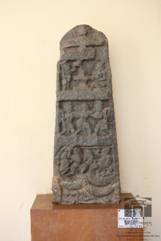
8. The hero stone shown here depicts a double-ended vessel in the lower panel, with an elongated curve, it shows carrying soldiers armed with bows, spears and shields. While the middle panel narrates that the martyr has been taken to heaven, in the top panel there is a Shivalinga being worshipped by devotees. Image courtesy- ASI, Goa
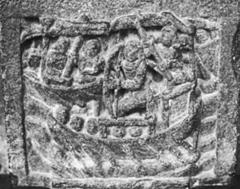
9. Canoe-type craft propelled by seven rowers. Image courtesy- ASI, Goa
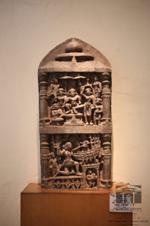
10. This vessel is broad in proportion to its length, with a sharp stern. It depicts a battle where a soldier is shown wounded by a spear. Image courtesy- ASI, Goa
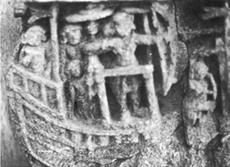
11. The panel depicts a full house naval ship with soldiers armed with bow and arrow. Image source- Dr. Sila Tripathi.
Gujarat hero stones
During the recent marine archaeological explorations, a number of hero stones were noticed in Aramda village and three of them have boat motifs. Out of the two hero stones have inscriptions and most portions of inscriptions are damaged and defaced. They are datable around 18th century CE and relate mostly to the Kharva community of Gujarat.
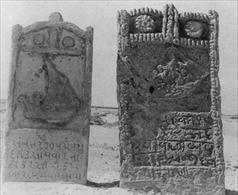
12. Hero stones from Aramda, Gujarat. Image courtesy-National Institute of Oceanography
Kutch has a very rich and documented maritime history. More study needs to be undertaken regarding these hero stones, their significance and documentation needs to be open for further research.
All these pieces of evidence provide ample evidence that the naval battles were very common along the Konkan coasts. These are still a very small volume of evidence, there lies a sizable data to support and aggregate the Naval history of India.
A detailed and extensive survey in this regard would be more efficient to find more hero stones. Further naval warfare hero stones have not been reported from the East Coast of India. The maritime history and the practice of naval warfare in India are very old; however, no evidence of hero stones depicting naval battles belonging to the ancient period have come to limelight. Now the question can be raised as why a very few of them are available, though we have a very rich history of maritime associations, probably we were not into wars rather we were emphasizing more on trade and prosperity of mankind, while hero stones are commemorated as war memorials. There could be many more answers to this aspect, we need to search them and put them forward. But the fascinating aspect of hero stones always escalates my mind about the hero, his legacy, his life.
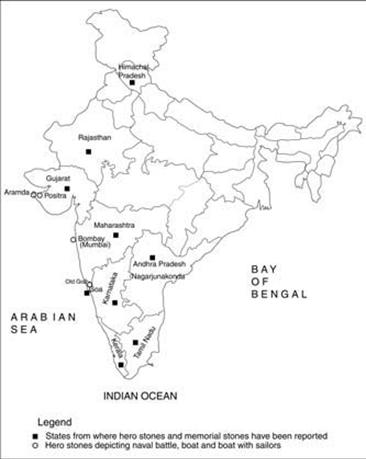
13. Image courtesy: Dr. Sila Tripathi
Author details:
Mukesh Sharma, Assistant Curator (Research), National Maritime Heritage Complex, Lothal, Gujarat
